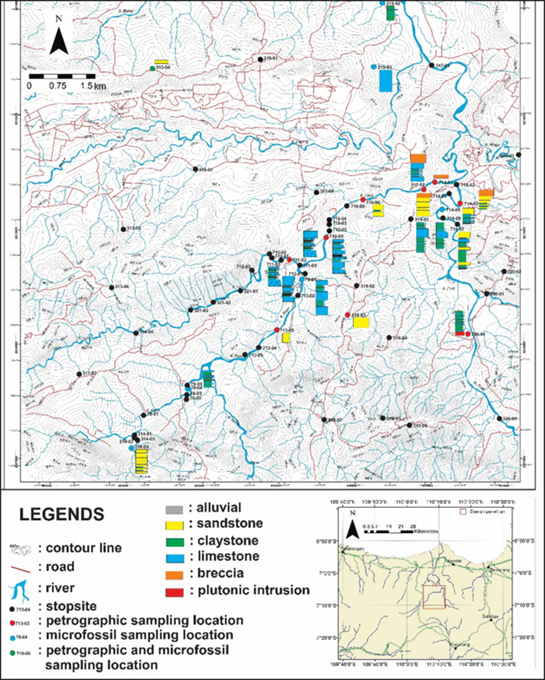Biostratigraphic Interpretation of Lutut Beds, Kerek Formation, Based on Foraminifera Fossils
DOI:
https://doi.org/10.25299/jgeet.2023.8.2.12462Keywords:
foraminifera, Lutut Beds, reworked bioclastsAbstract
Lutut Beds are the sandstone beds exposed in the northwest margin of Kendeng Basin, which contain abundant metamorphic-quartz grains, frequent recycled sedimentary quartz, and reworked bioclasts. Lutut Beds are not shown on the regional geological map and are often neglected in determining the geological history of Kendeng Basin. However, they have significant roles because it was deposited on the basin edge, which may carry important keys. This study aims to discover the larger and smaller foraminifera fossils contained in the Lutut Beds. Outcrop samples were collected in Kali Lutut and its surrounding area, including Lutut Beds and its overlying layers. Larger foraminifera was identified within 3 of 11 thin sections, mostly of Order Rotaliida, which occur as reworked bioclasts. The smaller foraminifera was barely found in most samples except for the samples from the overlying layers of Lutut Beds. The study reveals that Lutut Beds were deposited during Early to Middle Miocene, marked by the occurrence of Miogypsina sp. and Miogypsinoides sp. and also contains reworked Eocene – Early Oligocene larger foraminifera such as Nummulites sp., Discocyclina sp., and Dictyoconus sp. Besides, the overlying layer of Lutut Beds is identified to be deposited in the Middle Miocene to Pliocene based on the occurence of smaller planktonic foraminifera, Sphaeroidinella subdehiscens. The bathymetric interpretation based on smaller benthic foraminifera showed that Lutut Beds were deposited in the upper-middle bathyal zone. We also believe that the larger benthic foraminifera fossils in Lutut Beds were transported along the slope from its original life position. Accordingly, it is considered as allochthonous fossils.
Downloads
References
Adha, I., Sapiie, B., 2019. Rekonstruksi struktur geologi Kali Lutut dan sekitarnya, Temanggung, Jawa Tengah. J. Geosains dan Teknol. 2, 61–68.
Armstrong, H, Brasier, M., 2005. MICROFOSSILS 2nd Edition. Blackwell Publishing, Australia.
Blow, W.H., 1969. Late Middle Eocene to Recent planktonik foraminiferal biostratigraphy. 1st Int. Conf. Planktonik Microfossils Proc. 199–421.
BouDagher-Fadel, M.K., 2018. Biology and Evolutionary History of Larger Benthic Foraminifera, in: Evolution and Geological Significance of Larger Benthic Foraminifera Foraminifera. UCL Press, p. 45.
BouDagher-Fadel, M.K., Price, G.D., 2013. The phylogenetic and palaeogeographic evolution of the miogypsinid larger benthic foraminifera. J. Geol. Soc. London. 170, 185–208.
Hohenegger, J., Yordanova, E., 2001. Displacement of Larger Foraminifera at the Western Slope of Motobu Peninsula (Okinawa, Japan). Palaios 16, 53.
Holbourn, A., Henderson, A.S., MacLeod, N., 2013. Atlas of deep-sea benthic foraminifera. Wiley-Blackwell.
Hottinger, L., 1983. Processes determining the distribution of larger foraminifera in space and time. Utr. Micropaleontol. Bull. 30, 239–253.
Loeblich, A.R., Tappan, H., 1988. Foraminiferal Genera and Their Classification. J. Foraminifer. Res. 18, 271–274.
Lowe, D.R., 1975. Water escape structures in coarse‐grained sediments. Sedimentology 22, 157–204.
Lunt, P., 2013. The Sedimentary Geology of Java. Indonesian Petroleum Association.
Lunt, P., Allan, T., 2004. A history and application of larger foraminifera in Indonesian biostratigraphy , calibrated to isotopic dating. GRDC Museum Workshop on Micropaleontology.
Morkhoven, F.P.C.M., Berggren, W.A., Edward, S.A., 1986. Cenozoic cosmopolitan deep-water benthic foraminifera. Pau.Elf-Aquitaine.Postuma, J.A., 1971. Manual of Planktonic Foraminifera, Micropaleontology. Elsevier Publishing Company, Amsterdam.
Renema, W., Racey, A., Lunt, P., 2003. Paleogene nummulitid foraminifera from the Indonesian Archipelago: a review. Cainozoic Res. 2, 23–78.
Smyth, H., Hall, R., Hamilton, J., Kinny, P., 2005. East Java: Cenozoic basins, volcanoes and ancient basement. Proceedings, Indones. Pet. Assoc. Thirtieth Annu. Conv. Exhib. 251–266.
Smyth, H.R., Hall, R., Nichols, G.J., 2008. Significant Volcanic Contribution to Some Quartz-Rich Sandstones, East Java, Indonesia. J. Sediment. Res. 78, 335–356.
Thaden, R.E., Sumadirdja, H., Richards, P.W., 1996. Peta Geologi Lembar Magelang dan Semarang, Jawa.
Van Bemmelen, R.W., 1949. The Geology of Indonesia. General Geology of Indonesia and Adjacent Archipelagoes. Gov. Print. Off. Hague.
Vlerk, I.M. Van Der, 1955. Correlation of the Tertiary of the Far East and Europe. Micropaleontology 1, 72.

Downloads
Published
Issue
Section
License
Copyright @2019. This is an open-access article distributed under the terms of the Creative Commons Attribution-ShareAlike 4.0 International License which permits unrestricted use, distribution, and reproduction in any medium. Copyrights of all materials published in JGEET are freely available without charge to users or / institution. Users are allowed to read, download, copy, distribute, search, or link to full-text articles in this journal without asking by giving appropriate credit, provide a link to the license, and indicate if changes were made. All of the remix, transform, or build upon the material must distribute the contributions under the same license as the original.










